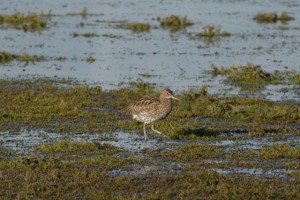State of Birds in Wales 2011

The State of Birds in Wales report published yesterday charts the fortunes of Welsh birdlife, and the successes of, and challenges for, conservation action.

For more than a decade, conservationists have been sounding alarm bells over declining numbers of many birds of farmed habitats in Wales. So the increase, from an all time low, in the Wild Bird Indicator – part of the Welsh Government’s way of measuring the health of the environment – has been cautiously welcomed.
The picture that makes up the Wild Bird Indicator is complex though, and changes between two individual years do not necessarily reflect the underlying trend. Some birds such as linnet, blackcap and tree pipit have increased significantly on the previous year, which has contributed to the upswing in the Wild Bird Indicator.
However, the picture is not positive for other species. Those that have declined most since 1994, such as curlew (49%), swift (50%) and starling (63%) showed much smaller increases on the previous year, and there is a long way to go to return these birds to their historic levels.
Richard Hearn, Head of Species Monitoring at WWT explained how waterbirds are faring: “The status of waterbirds in Wales is a story of winners and losers. Some species, such as pochard and curlew, show Wales’s waterbirds are by no means secure; curlew has declined significantly in the breeding and wintering periods, both in Wales and elsewhere, and these widespread declines mean this species is now recognized as globally near-threatened.
"Declines of other species also need to be assessed within a flyway context, and new information from the Baltic Sea shows that red-breasted merganser numbers are also of concern there as well as in Wales.
"Other species are thankfully doing well; pintail and black-tailed godwit for example have increased notably, showing that wetland habitats in Wales being used by these species remain healthy.”
The other partners which contribute to the report also commented.
Ian Johnstone, RSPB Cymru Senior Conservation Scientist says: “We have seen up turns in the wild bird indicator in previous years, but these have not been sustained and have been followed by further decline. Whilst good news, we need more years of monitoring before we can tell whether some of Wales’s declining species have now started a sustained recovery.”
David Noble, Principal Ecologist for Monitoring at the BTO, said “The wild bird indicator does indicate a recent upturn in numbers but we know that bird populations respond to many different factors and can bounce back from short-term crashes. It is essential that the tremendous monitoring efforts of Wales’s volunteer birdwatchers are complemented by further investigation of the causes of change in bird communities, especially the continuing declines in farmland specialists such as starling, curlew and yellowhammer.”
Dr Siân Whitehead, Terrestrial & Freshwater Ornithologist for the Countryside Council for Wales said: “From this report, the urgency of conservation action for some breeding species such as golden plover and twite is clear. It is crucial that land managers and conservationists work together for their benefit before we lose them forever."
Ian Spence, Secretary of the Welsh Ornithological Society said: “The strength of evidence for the alarming declines of some of our native species would not be possible without the massive contribution made by volunteer bird surveyors. Both they, and the organizations that present the results of their efforts in reports like this, need all the support they can to safeguard Wales’ birds.”
The State of Birds in Wales is compiled annually to provide a snapshot of bird populations in Wales. A tremendous effort by volunteers, county bird recorders and representatives from a range of organisations helps to shape the report.